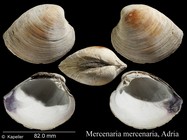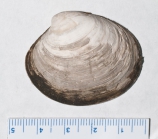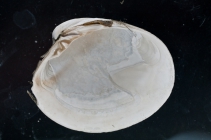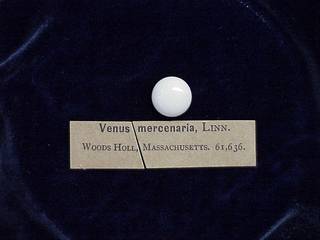
| Introduction | | Search taxa | | Taxon tree | | Taxon match | | Checklist | | Literature | | Stats | | Photogallery | | OBIS Vocab | | Log in |
CaRMS taxon detailsMercenaria mercenaria (Linnaeus, 1758)
141919 (urn:lsid:marinespecies.org:taxname:141919)
accepted
Species
marine
(of ) Linnaeus, C. (1758). Systema Naturae per regna tria naturae, secundum classes, ordines, genera, species, cum characteribus, differentiis, synonymis, locis. [The system of nature through the three kingdoms of nature, according to classes, orders, genera, species, with characters, differences, synonyms, places.]. <em>Impensis Direct. Laurentii Salvii. Holmiae [Stockholm].</em> 1(10) [iii], 824 p., available online at https://biodiversitylibrary.org/page/726886
page(s): 686 [details] Available for editors
Distribution Newfoundland to Florida and Texas
Distribution Newfoundland to Florida and Texas [details]
MolluscaBase eds. (2021). MolluscaBase. Mercenaria mercenaria (Linnaeus, 1758). Accessed through: Nozères, C., Kennedy, M.K. (Eds.) (2021) Canadian Register of Marine Species at: http://marinespecies.org/carms./aphia.php?p=taxdetails&id=141919 on 2025-05-09
Nozères, C., Kennedy, M.K. (Eds.) (2025). Canadian Register of Marine Species. Mercenaria mercenaria (Linnaeus, 1758). Accessed at: https://www.marinespecies.org/CaRMS/aphia.php?p=taxdetails&id=141919 on 2025-05-09
Date action by
original description
(of ) Linnaeus, C. (1758). Systema Naturae per regna tria naturae, secundum classes, ordines, genera, species, cum characteribus, differentiis, synonymis, locis. [The system of nature through the three kingdoms of nature, according to classes, orders, genera, species, with characters, differences, synonyms, places.]. <em>Impensis Direct. Laurentii Salvii. Holmiae [Stockholm].</em> 1(10) [iii], 824 p., available online at https://biodiversitylibrary.org/page/726886
page(s): 686 [details] Available for editors context source (Introduced species) Katsanevakis, S.; Bogucarskis, K.; Gatto, F.; Vandekerkhove, J.; Deriu, I.; Cardoso A.S. (2012). Building the European Alien Species Information Network (EASIN): a novel approach for the exploration of distributed alien species data. <em>BioInvasions Records.</em> 1: 235-245., available online at http://easin.jrc.ec.europa.eu [details] Available for editors context source (Schelde) Maris, T., O. Beauchard, S. Van Damme, E. Van den Bergh, S. Wijnhoven & P. Meire. (2013). Referentiematrices en Ecotoopoppervlaktes Annex bij de Evaluatiemethodiek Schelde-estuarium Studie naar “Ecotoopoppervlaktes en intactness index”. [Reference matrices and Ecotope areas Annex to the Evaluation methodology Scheldt estuary Study on “Ecotope areas and intactness index”. <em>Monitor Taskforce Publication Series, 2013-01. NIOZ: Yerseke.</em> 35 pp. (look up in IMIS) [details] context source (Bermuda) Jensen, R. H. (1997). A Checklist and Bibliography of the Marine Molluscs of Bermuda. Unp. , 547 pp [details] basis of record Gofas, S.; Le Renard, J.; Bouchet, P. (2001). Mollusca. in: Costello, M.J. et al. (eds), European Register of Marine Species: a check-list of the marine species in Europe and a bibliography of guides to their identification. <em>Patrimoines Naturels.</em> 50: 180-213., available online at http://www.vliz.be/imisdocs/publications/ocrd/254404.pdf [details] additional source Davis, J. D. (1969). <i>Polydora</i> infestation of <i>Mercenaria mercenaria</i>. <em>The Nautilus.</em> 83(2): 74., available online at https://www.biodiversitylibrary.org/page/8515342 [details] additional source Huber, M. (2010). <i>Compendium of bivalves. A full-color guide to 3,300 of the world's marine bivalves. A status on Bivalvia after 250 years of research</i>. Hackenheim: ConchBooks. 901 pp., 1 CD-ROM. (look up in IMIS) [details] additional source Occhipinti-Ambrogi, A., A. Marchini, G. Cantone, A. Castelli, C. Chimenz, M. Cormaci, C. Froglia, G. Furnari, M.C. Gambi, G. Giaccone, A. Giangrande, C. Gravil, F. Mastrototaro, C. Mazziotti, L. Orsi-Relini & S. Piraino. (2010). Alien species along the Italian coasts: an overview. <em>Biological Invasions.</em> 13(1): 215-237., available online at https://doi.org/10.1007/s10530-010-9803-y [details] Available for editors additional source Zenetos, A., S. Gofas, M. Verlaque, M. Cinar, J. Garcia Raso, C. Bianchi, C. Morri, E. Azzurro, M. Bilecenoglu, C. Froglia, I. Siokou, D. Violanti, A. Sfriso, G. San Martin, A. Giangrande, T. Katagan, E. Ballesteros, A. Ramos-Espla, F. Mastrototaro, O. Ocana, A. Zingone, M,. Gambi & N. Streftaris. (2010). Alien species in the Mediterranean Sea by 2010. A contribution to the application of European Union's Marine Strategy Framework Directive (MSFD). Part I. Spatial distribution. <em>Mediterranean Marine Science.</em> 11(2): 381-493., available online at https://doi.org/10.12681/mms.87 [details] additional source Lutaenko, K.A.; Furota, T.; Nakayama; S.; Shin, K.; Xu, J. (2013). Atlas of Marine Invasive Species in the NOWPAP Region. Beijing: NOWPAP DINRAC (Northwest Pacific Action Plan, Data and Information Network Regional Center). 189 pp. [details] additional source Tubiash, H. S., Shuster, C. N., Jr. & Couch, J. A. (1968). Anomalous siphons in two species of bivalve mollusks. <em>The Nautilus.</em> 81(4): 123-125, figs. 1-3., available online at https://www.biodiversitylibrary.org/page/8528148 [details] additional source Walker, R. L. (1984). Effects of density and sampling time on the growth of the hard clam, <i>Mercenaria mercenaria</i>, planted in predator-free cages in coastal Georgia. <em>The Nautilus.</em> 98(3): 114-119., available online at https://www.biodiversitylibrary.org/page/8277148 [details] additional source Walker, R. L. (1985). Growth and optimum seeding time for the hard clam. <i>Mercenaria mercenaria</i> (L.), in coastal Georgia. <em>The Nautilus.</em> 99(4): 127-133., available online at https://www.biodiversitylibrary.org/page/8276789 [details] additional source Goodsell, J. G. & Eversole, A. G. (1992). Prodissoconch I and II length in <i>Mercenaria</i> taxa. <em>The Nautilus.</em> 106(3): 119-122, fig. 1., available online at https://www.biodiversitylibrary.org/page/8271365 [details]  Present Present  Inaccurate Inaccurate  Introduced: alien Introduced: alien  Containing type locality Containing type locality
From regional or thematic species database
Introduced species abundance in Celtic Sea (IHO Sea Area) : Rare [details]Introduced species impact in United Kingdom (Nation) : Other impact - undefined or uncertain [details] Introduced species impact in Celtic Sea (IHO Sea Area) : Other impact - undefined or uncertain [details] Introduced species impact in United Kingdom part of the North Sea (Marine Region) : Other impact - undefined or uncertain [details] Introduced species impact in North Sea (IHO Sea Area) : Other impact - undefined or uncertain [details] Introduced species impact Chinese part of the Eastern Chinese Sea(Marine Region) Pathogen/parasite or carrier of a pathogen/parasite [details] Introduced species impact Chinese part of the Yellow Sea (Marine Region) Pathogen/parasite or carrier of a pathogen/parasite [details] Introduced species population United Kingdom part of the North Sea (Marine Region) Regionally established [details] Introduced species remark in United Kingdom part of the North Sea (Marine Region) : localised fishery [details] Introduced species vector dispersal in Celtic Sea (IHO Sea Area) : Fisheries: deliberate translocations of fish or shellfish to establish or support fishery [details] Introduced species vector dispersal in English Channel (IHO Sea Area) : Shipping [details] Introduced species vector dispersal in United Kingdom part of the North Sea (Marine Region) : Ships: general [details] Introduced species vector dispersal in North Sea (IHO Sea Area) : Fisheries: accidental as bait Originally imported as eel bait. Spread through UK via larval dispersal on water currents. Dumping and deliberate introduction attempts by fishermen and fishery scientists also influence its spread. [details] Introduced species vector dispersal United States part of the North Pacific Ocean (Marine Region) Aquaculture: deliberate [details] Introduced species vector dispersal Belgian part of the North Sea (Marine Region) Ships: general [details] Introduced species vector dispersal Chinese part of the Yellow Sea (Marine Region) Aquaculture [details] Introduced species vector dispersal Chinese part of the Eastern Chinese Sea (Marine Region) Aquaculture [details] Unreviewed
Dimensions reaches 7.5 to 12 cm in size [details]Distribution Newfoundland to Florida and Texas [details] Habitat intertidal and infralittoral of the Gulf and estuary [details] Importance used for chowders [details] Reproduction separate sexes, usually not dimorphic in shell structure; fertilization occurs within the mantle cavity anf young hatch as pelagic larvae (generalized for group) [details] alien species The natural range of distribution of the northern quahog Mercenaria mercenaria spreads along the east coast of the United States, but the species was intentionally introduced in France in 1861 for farming purpose. The northern quahog was later introduced into several other European countries with the same goal. Later on, the species was often transported by accident together with oysters. The first Belgian specimens were found in the Spuikom in Ostend around 1933. In the 1990’s and the start of this century, the species was reintroduced several times for farming purposes. [details]
Marine Life Information Network - UK
To Barcode of Life (239 barcodes) To Biodiversity Heritage Library (150 publications) To Biological Information System for Marine Life (BISMaL) To European Nucleotide Archive, ENA (Mercenaria mercenaria) To FAO Cultured Aquatic species fact sheets To FAO Species fact sheets To GenBank (83721 nucleotides; 63471 proteins) To Global Biotic Interactions (GloBI) To Information system on Aquatic Non-Indigenous and Cryptogenic Species (AquaNIS) To Malacopics (Mercenaria mercenaria (Linnaeus, 1758) France, Bretagne, ex coll. J. Trausel) To Malacopics (Mercenaria mercenaria (Linnaeus, 1758) Netherlands, Zeeland, Tholen, Gorishoek, sam... To Malacopics (Mercenaria mercenaria (Linnaeus, 1758) Netherlands, Zeeland, Zuid-Beveland, Reimers... To Malacopics (Mercenaria mercenaria (Linnaeus, 1758)) To Marine Bivalves of the British Isles webpage at National Museum of Wales To NMNH Extant Collection (IZ MOL 61636 Pearl) To NMNH Extant Collection (IZ MOL 90625 Pearl) To PESI To USNM Invertebrate Zoology Mollusca Collection To Yale Peabody Museum of Natural History (YPM IZ 098340) To ITIS |





.jpg)
.jpg)



